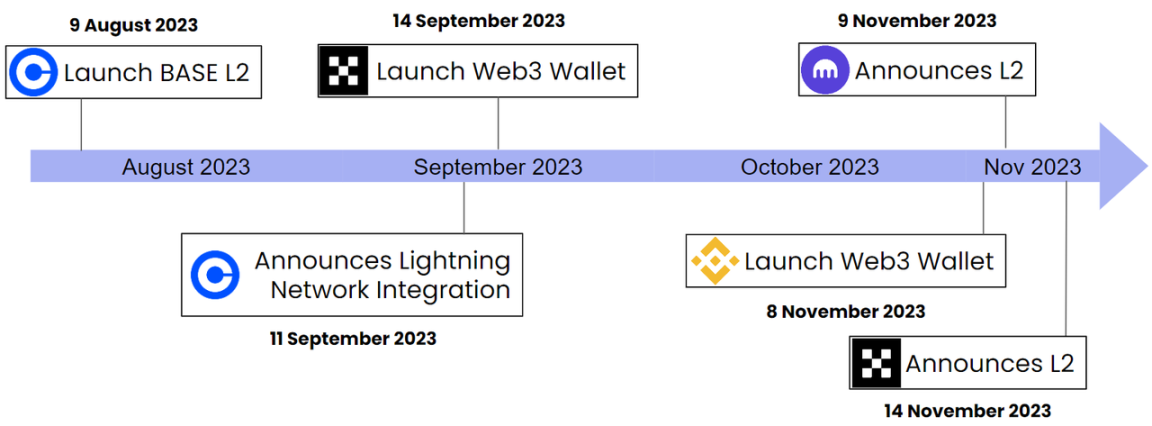Outlier Ventures: How can CEX, which is going open source, build an economic moat?
Original author: Jasper De Maere, Outlier Ventures
Original compilation: Peng SUN, Foresight News
The battle for crypto users is taking on a new shape. We see exchanges moving from closed to open systems as they adopt Web3 wallets, build EVM L2, and adopt existing infrastructure like the Lightning Network. We are excited about these developments and believe they represent a differentiated value proposition for existing open source Web3 networks. As previous technology cycles have proven, companies entering open source networks need to play the game differently. We believe community and innovation are the secrets to success, and these factors will determine how successful exchanges and financial institutions participate in open source.
open source
Open source is a broad definition used in software, which simply means that anyone can inspect, modify, and improve the source code. There are different types of open source such as libraries, networking, and infrastructure. We specialize in open source Web3 networks and infrastructure, such as blockchain and wallet solutions.
Innovation is key
In this short article, we highlight the importance of innovation in open source networks. This is a key factor in the long-term success of the network and a mechanism to counter other networks that pursue financial value too much.
The exchange is on the road to open source
Over the past two months, we have seen a series of announcements from centralized crypto exchanges announcing their move from closed to open-source systems, including the upcoming launch of Layer 2 and Layer 3 wallets.
Exchange announcement schedule

Fusion
Since 2022, we have seen DEX and CEX converge in functionality, as evidenced by the move from CEX to open source exchanges. We believe that there are two key driving factors behind the development of CEX:
Products: People want to develop new and exciting DeFi products that require innovations such as EVM compatibility, zero-knowledge proofs, and multi-party computation, which can only be achieved through blockchain technology.
Liquidity: Although the liquidity of CEX is still much higher than that of DEX (CEX is $3 trillion per month, while DEX is $31 billion per month), CEX is still looking to increase DeFi liquidity. Liquidity on CEX is typically concentrated on blue-chip assets such as BTC and ETH. Users will benefit from being able to access DEX liquidity pools for long-tail, low-cap tokens, as it becomes increasingly difficult for CEXs to maintain and manage liquidity for these tokens.

As CEXs continue to embed open source infrastructure into their products, the lines between CEXs and DEXs will become even more blurred. We are excited about this development because it shows that the decentralized open source web (Web3) not only provides users with an alternative to centralization, but also directly affects centralized institutions to make them more inclusive. and more efficient ecosystems.
We believe that cryptocurrency exchanges are the first of many financial services sectors to move to open source systems. While we haven’t seen banks or asset managers adopting open source systems yet, we know they are experimenting with permissioned blockchains and Web2.5 wallets.
The economic moat of open source
Many people believe that it is impossible for entities (protocols, companies, etc.) to capture value in open source systems. The ability to fork a network or duplicate code leads many to believe that entities will become obsolete if they become too commercialized.
If it werent for network effects, theyd be right. The economic moat commonly used by Web2 platforms also has some relevance to open source systems. The difference is that in the Web3 open source network, users control and participate in the value they create for the network.
Closed networks create and sustain network effects in very different ways than open-source networks. The creation of open source network effects depends on the successful execution of two things:
Community
Open source network is the accumulation of community efforts
The existence of the open source network cannot be separated from the community. The Web3 community plays a vital role in driving the development, recognition, and adoption of blockchain projects. Traditional companies struggle to plan internal product development. The world of open source is no exception. Exchanges operating in an open source manner need to put in the same effort to prioritize and build their L2 community. Strong communities create network effects among different users who increasingly benefit from the size and quality of the community.
Innovation
Innovation ensures open source networks remain relevant and competitive
Innovation plays a key role in strengthening and amplifying network effects. When innovative features, services or technologies are introduced to the network, more users will participate. Through innovation, networks can stay relevant and not only attract existing users, but also achieve user growth. Innovation also brings a sense of accomplishment and progress to communities built on open source networks.
In summary, we believe that exchanges entering the open source space through their own L2 need to continue to stimulate community interest in their products through innovation and community building.
Web3 Network Effects
We are seeing increasing evidence that Web3 protocols are successfully capturing value. This can create network effects by making the Web3 protocol more valuable to each user. Users can switch to new applications simply by forking the code, but this is not cost-free. There are switching costs for leaving the protocol and its users.
Without swaying the community vote, we believe the recent debate in the Uniswap community surrounding its fee conversion proposal is an example of how network effects can create economic moats, even in open source networks. In short, Uniswap Labs has come up with a new proposal to introduce a 0.15% trading fee on its frontend and wallet.
We believe that there is currently no case where open source networks excessively pursue commercial value. But if this trend continues, innovation will be the key to checks and balances. Due to network effects, simply forking the network and rebuilding it using open source code is not a real solution. We need to innovate, create new value propositions, and add differentiated and practical functions for users.
Neutral and Company are open source
Exchanges are launching their own L2s in an attempt to expand product suites and tap into DeFi liquidity. Now that these L2s supported by centralized institutions have come online, we can see two types of L2s with different strategies:
Neutral L2 - L2 without pre-existing customer base or large centralized authority support
Company L2 - As an extension of the products and services of large centralized institutions, L2 is expanding into the open source field.
The success of both approaches depends on different strategies, from seamless onboarding of existing users to attracting successful DApp launches on the L2 ecosystem. While there are nuances in strategy, innovation is a priority for both parties. Actively promoting innovation within open networks is critical to ensuring their long-term success. Open systems thrive when we encourage communities to create and innovate. We believe that there will be a strong positive correlation between future innovation and the success of different L2s.
Summarize
At Outlier Ventures, we are excited to discover and validate new trends in open source systems. Some of the inefficiencies observed in closed systems will no longer exist in open source systems. This is why we would like to see CEX’s L2 strategy shift towards a focus on innovation and community. We believe that successful innovation and community building will play a more important role in determining the overall success of these institutions.



